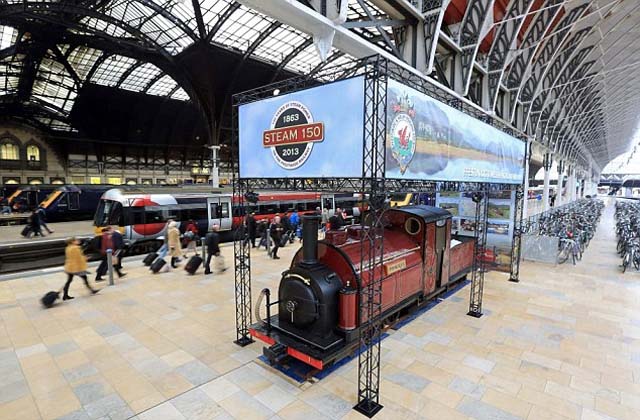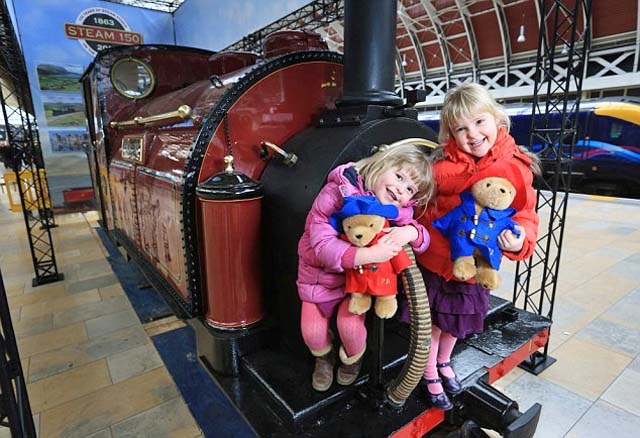|


Golden age of travel: Engineers install the Princess at Paddington station today - Date/Photographer unknown.
25 February 2013
Princess Returns to Paddington
to Celebrate 150th Birthday
London England United Kingdom - Train passengers nostalgic for the age of steam will be heartened to see the latest arrival at
Paddington station.
Princess, the world's first narrow gauge steam engine, has returned to London for the first time since she was built there 150 years ago.
But commuters will have a long wait if they try to board the train, as she isn't due to depart the station for another six weeks.

Pride of place: The Princess will be on display on Platform Nine for the next six weeks - Date/Photographer unknown.
The steam train has been painstakingly restored by the craftsmen at Ffestiniog Railway in North Wales and will be unveiled to the public on Saint David's
Day on Friday.
She will remain on display on Platform Nine at the station until April and Ffestiniog Railway staff and volunteers will be on hand to answer questions about
the engine and her railway.
The train will then travel to Ireland for a stint at Heuston Station in Dublin.

Bear necessities: Sisters Alexandra and Imogen pose with Paddington Bear toys on the Princess steam engine - Date/Photographer
unknown.
The locomotive was built in 1863, just 34 years after Stephenson's Rocket, by the Ffestiniog Railway to haul trains of empty slate wagons from the harbour at
Porthmadog to the quarries of Blaenau Ffestiniog in North Wales.
Six narrow gauge steam locomotives were built by George England & Company at their Hatcham Iron Works in New Cross, London, and the Princess is one of four
that has survived.
She was named after Princess Alexandra of Denmark, who had married Albert Edward, Prince of Wales. and later Edward VII. the year she was built.
The Ffestiniog was the first railway in the world to adopt and make regular use of steam locomotives on a very narrow gauge, on a public railway, and over a
significant distance.
Reportedly, when the founders of Ffestiniog Railway announced their intention to construct the line, they were laughed at by contemporaries such as Robert
Stephenson and Isambard Kingdom Brunel, who didn't believe that the engines would be sufficient to pull slate carts over the rugged terrain.
They were proved wrong and the technology and skills developed on the Ffestiniog were exported around the world, leading to the proliferation of narrow gauge
railways in other countries where inexpensive and cost-effective systems were required.
The narrow gauge railways of France, India, USA, Hungary, South Africa, Namibia, Venezuela, New Guinea, and Morocco, as well as industrial systems and those
built in the trenches of the First World War can all trace their roots back to a 13-mile line in North Wales.
The Ffestiniog Railway and the Welsh Highland Railway combine to make the UK's longest heritage railway, with the two lines offering tourists a journey across
Snowdonia National Park, past the foot of Snowdon, and along the length of the Aberglaslyn Pass, voted the most beautiful spot in the UK by members of the
National Trust.
Author unknown.



Vancouver Island
British Columbia
Canada
|



